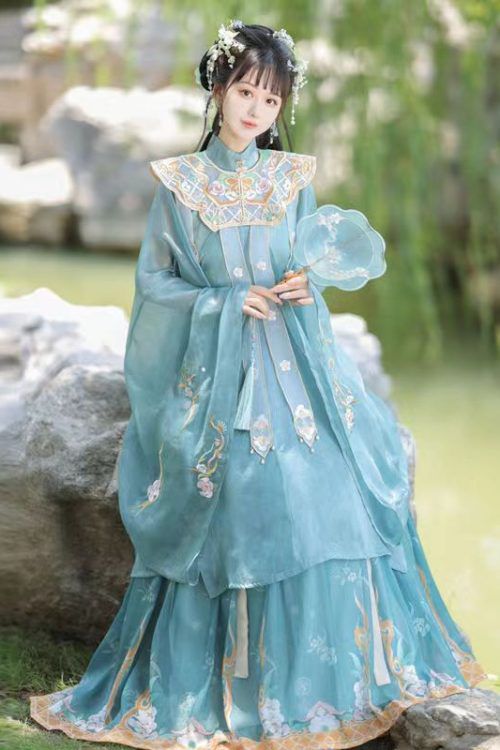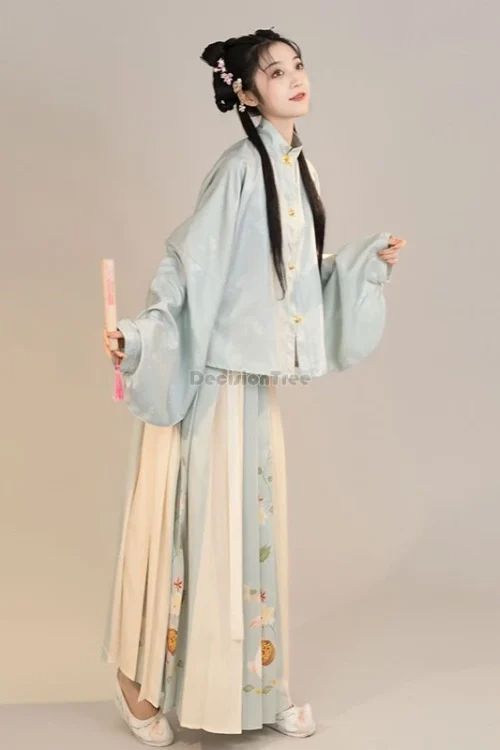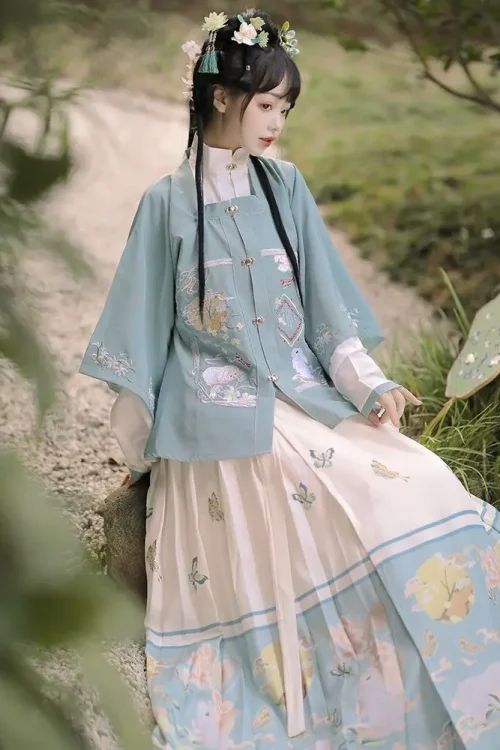The Vibrant Hues of Hanfu Dinasti Ming: Exploring the Symbolism of Color
In the tapestry of Chinese history, the Ming Dynasty stands out as an era of cultural and artistic brilliance. Among its many contributions, the exquisite Hanfu, or pakaian tradisional Tiongkok, holds a special place. Beyond its aesthetic appeal, Hanfu carries profound symbolic meanings, particularly through its vibrant hues and intricate embroidery.

The Role of Color
Color played a pivotal role in Ming Dynasty Hanfu. Each shade held specific associations and conveyed social status, marital status, and even the wearer’s occupation.
- Merah: The most auspicious color, reserved for emperors, brides, and high-ranking officials.
- Kuning: Symbolized imperial power and was worn by the emperor and his family.
- Biru: Associated with scholars and literati, representing the sky.
- Hijau: Worn by commoners, symbolizing nature and prosperity.
Embroidery and Its Significance
Embroidery further enhanced the symbolism of Hanfu. Intricate designs, often featuring auspicious motifs such as dragons, phoenixes, and flowers, were meticulously stitched onto the garments.
- Dragons: Symbols of imperial authority, reserved for the emperor and his court.
- Phoenixes: Representing beauty and grace, often embroidered on women’s clothing.
- Flowers: Such as peonies and lotuses, symbolized prosperity, longevity, and purity.
Placement of Embroidery
The placement of embroidery also held significance.
- Dragons: Typically embroidered on the chest or back.
- Phoenixes: Placed on the shoulders or sleeves.
- Flowers: Scattered throughout the garment, creating a harmonious visual effect.
Cultural Communication
The symbolism of color and embroidery in Ming Dynasty Hanfu extended beyond aesthetics. It served as a visual language that communicated the wearer’s identity, status, and aspirations. By understanding these symbols, we gain a deeper appreciation for the cultural and social significance of this exquisite attire.
Kesimpulan
In conclusion, the vibrant hues and intricate embroidery of Ming Dynasty Hanfu were not merely decorative elements. They carried profound symbolic meanings that reflected the wearer’s social status, marital status, occupation, and aspirations. Through its rich symbolism, Hanfu served as a visual representation of the cultural and social fabric of Ming Dynasty China.
Threads of Tradition: The Embroidery Motifs and Their Meaning in Ming Dynasty Hanfu
In the tapestry of Chinese history, the Ming Dynasty (1368-1644) stands out as an era of cultural and artistic brilliance. Among its many contributions, the Hanfu, the traditional Chinese garment, reached unprecedented heights of sophistication and symbolism.

Color Symbolism
Color played a pivotal role in the symbolism of Ming Dynasty Hanfu.
- Merah: Reserved for the emperor and his family, representing power and prosperity.
- Kuning: Associated with the imperial court, symbolizing authority and wisdom.
- Biru: Representing tranquility and harmony.
- Hijau: Symbolizing growth and renewal.
- Putih: Worn during mourning periods as a color of purity.
The Art of Embroidery
Embroidery, an art form that flourished during the Ming Dynasty, further enhanced the symbolic significance of Hanfu. The motifs depicted on these garments were carefully chosen to convey specific messages.
- Dragons: Symbols of power and protection, often associated with the emperor.
- Phoenixes: Representing beauty and grace, often adorning empresses’ garments.
- Cranes: Symbols of longevity, commonly embroidered on garments for elderly wearers.
- Peonies: Popular motifs for wealthy merchants, symbolizing wealth and honor.
Placement of Motifs
The placement of embroidery on Hanfu also carried symbolic meaning.
- Front: Reserved for formal and auspicious motifs.
- Back: Often adorned with personal designs.
- Sleeves and Collars: Popular areas for intricate and eye-catching embroidery.
Practical Aspects
In addition to its symbolic significance, the embroidery on Ming Dynasty Hanfu also served a practical purpose, reinforcing the seams of the garment and enhancing its durability.
Kesimpulan
The symbolism of color and embroidery in Ming Dynasty Hanfu extended beyond aesthetics. These garments embodied the wearer’s identity, beliefs, and aspirations, showcasing the cultural and artistic achievements of the Ming Dynasty.
The Art of Adornment: How Color and Embroidery Conveyed Status and Identity in Ming Dynasty Hanfu
In the opulent tapestry of Ming Dynasty China, Hanfu, the traditional attire, served as a vibrant canvas upon which the intricate interplay of color and embroidery unfolded.

Significance of Color
Color, in its myriad hues, held deep significance.
- Merah: Adorning the pakaian of brides and high-ranking officials, it symbolized joy and celebration.
- Kuning: Exclusively for the imperial family, symbolizing divine authority.
- Biru: Representing tranquility and wisdom, associated with the sky.
- Hijau: Evoking harmony and prosperity, linked to nature.
Embroidery as Expression
Embroidery, with its delicate threads and intricate patterns, further enriched the symbolism of Hanfu.
- Dragons: Embroidered on emperors’ robes, symbolizing imperial power.
- Phoenixes: Adorning empresses’ garments, representing beauty and grace.
- Cranes: Common motifs signifying longevity and good fortune among scholars.
Meaningful Placement
The placement of embroidery conveyed meaning.
- Dragons: Typically on the chest or shoulders.
- Phoenixes: Often on the sleeves or skirts.
- Cranes: Commonly on the back or hem.
Practical Functions
Beyond their symbolic significance, color and embroidery served practical purposes. Bright colors attracted attention, while darker hues offered modesty. Embroidery reinforced seams and provided warmth.
Kesimpulan
In the Ming Dynasty, Hanfu was more than pakaian; it reflected the wearer’s place in society and their aspirations. Through the skillful use of color and embroidery, the Ming people celebrated their culture, traditions, and beliefs, creating a legacy that continues to inspire pride today.
